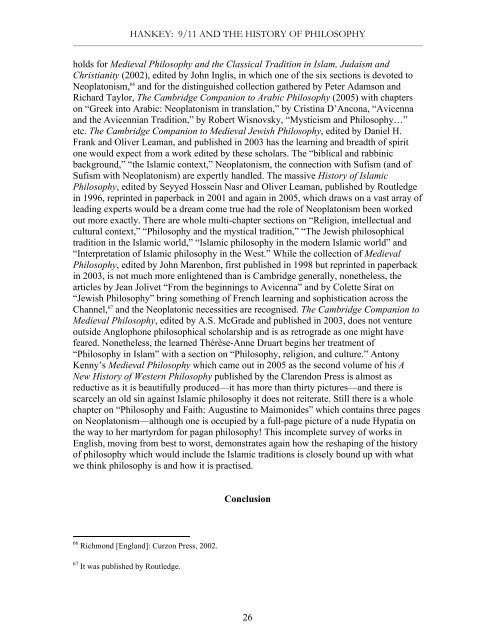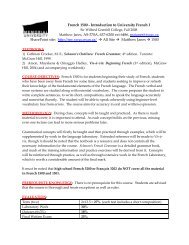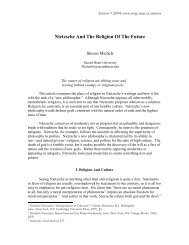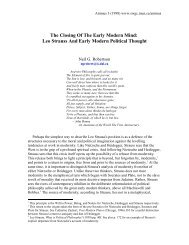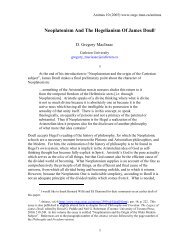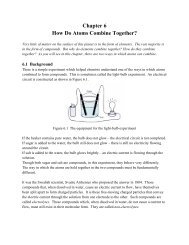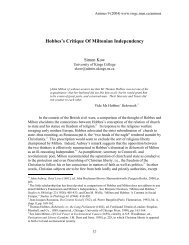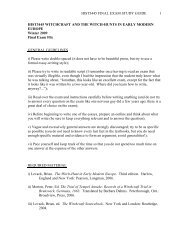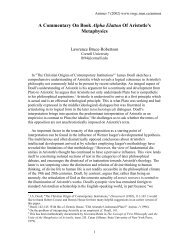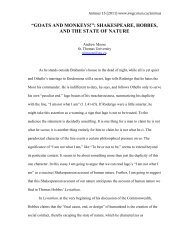Wayne Hankey, 9/11 and the History of Philosophy - Memorial ...
Wayne Hankey, 9/11 and the History of Philosophy - Memorial ...
Wayne Hankey, 9/11 and the History of Philosophy - Memorial ...
Create successful ePaper yourself
Turn your PDF publications into a flip-book with our unique Google optimized e-Paper software.
HANKEY: 9/<strong>11</strong> AND THE HISTORY OF PHILOSOPHYholds for Medieval <strong>Philosophy</strong> <strong>and</strong> <strong>the</strong> Classical Tradition in Islam, Judaism <strong>and</strong>Christianity (2002), edited by John Inglis, in which one <strong>of</strong> <strong>the</strong> six sections is devoted toNeoplatonism, 66 <strong>and</strong> for <strong>the</strong> distinguished collection ga<strong>the</strong>red by Peter Adamson <strong>and</strong>Richard Taylor, The Cambridge Companion to Arabic <strong>Philosophy</strong> (2005) with chapterson “Greek into Arabic: Neoplatonism in translation,” by Cristina D’Ancona, “Avicenna<strong>and</strong> <strong>the</strong> Avicennian Tradition,” by Robert Wisnovsky, “Mysticism <strong>and</strong> <strong>Philosophy</strong>…”etc. The Cambridge Companion to Medieval Jewish <strong>Philosophy</strong>, edited by Daniel H.Frank <strong>and</strong> Oliver Leaman, <strong>and</strong> published in 2003 has <strong>the</strong> learning <strong>and</strong> breadth <strong>of</strong> spiritone would expect from a work edited by <strong>the</strong>se scholars. The “biblical <strong>and</strong> rabbinicbackground,” “<strong>the</strong> Islamic context,” Neoplatonism, <strong>the</strong> connection with Sufism (<strong>and</strong> <strong>of</strong>Sufism with Neoplatonism) are expertly h<strong>and</strong>led. The massive <strong>History</strong> <strong>of</strong> Islamic<strong>Philosophy</strong>, edited by Seyyed Hossein Nasr <strong>and</strong> Oliver Leaman, published by Routledgein 1996, reprinted in paperback in 2001 <strong>and</strong> again in 2005, which draws on a vast array <strong>of</strong>leading experts would be a dream come true had <strong>the</strong> role <strong>of</strong> Neoplatonism been workedout more exactly. There are whole multi-chapter sections on “Religion, intellectual <strong>and</strong>cultural context,” “<strong>Philosophy</strong> <strong>and</strong> <strong>the</strong> mystical tradition,” “The Jewish philosophicaltradition in <strong>the</strong> Islamic world,” “Islamic philosophy in <strong>the</strong> modern Islamic world” <strong>and</strong>“Interpretation <strong>of</strong> Islamic philosophy in <strong>the</strong> West.” While <strong>the</strong> collection <strong>of</strong> Medieval<strong>Philosophy</strong>, edited by John Marenbon, first published in 1998 but reprinted in paperbackin 2003, is not much more enlightened than is Cambridge generally, none<strong>the</strong>less, <strong>the</strong>articles by Jean Jolivet “From <strong>the</strong> beginnings to Avicenna” <strong>and</strong> by Colette Sirat on“Jewish <strong>Philosophy</strong>” bring something <strong>of</strong> French learning <strong>and</strong> sophistication across <strong>the</strong>Channel, 67 <strong>and</strong> <strong>the</strong> Neoplatonic necessities are recognised. The Cambridge Companion toMedieval <strong>Philosophy</strong>, edited by A.S. McGrade <strong>and</strong> published in 2003, does not ventureoutside Anglophone philosophical scholarship <strong>and</strong> is as retrograde as one might havefeared. None<strong>the</strong>less, <strong>the</strong> learned Thérèse-Anne Druart begins her treatment <strong>of</strong>“<strong>Philosophy</strong> in Islam” with a section on “<strong>Philosophy</strong>, religion, <strong>and</strong> culture.” AntonyKenny’s Medieval <strong>Philosophy</strong> which came out in 2005 as <strong>the</strong> second volume <strong>of</strong> his ANew <strong>History</strong> <strong>of</strong> Western <strong>Philosophy</strong> published by <strong>the</strong> Clarendon Press is almost asreductive as it is beautifully produced—it has more than thirty pictures—<strong>and</strong> <strong>the</strong>re isscarcely an old sin against Islamic philosophy it does not reiterate. Still <strong>the</strong>re is a wholechapter on “<strong>Philosophy</strong> <strong>and</strong> Faith: Augustine to Maimonides” which contains three pageson Neoplatonism—although one is occupied by a full-page picture <strong>of</strong> a nude Hypatia on<strong>the</strong> way to her martyrdom for pagan philosophy! This incomplete survey <strong>of</strong> works inEnglish, moving from best to worst, demonstrates again how <strong>the</strong> reshaping <strong>of</strong> <strong>the</strong> history<strong>of</strong> philosophy which would include <strong>the</strong> Islamic traditions is closely bound up with whatwe think philosophy is <strong>and</strong> how it is practised.Conclusion66 Richmond [Engl<strong>and</strong>]: Curzon Press, 2002.67 It was published by Routledge.26


